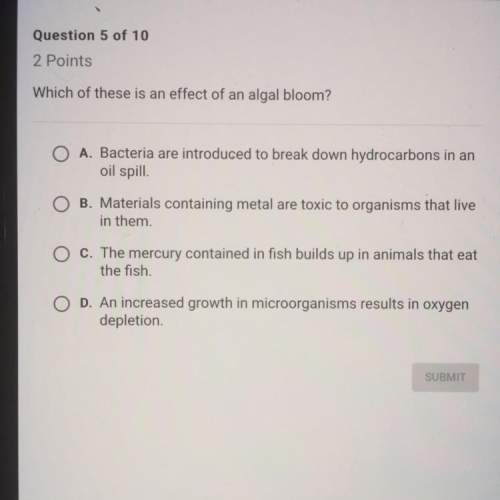
Biology, 27.07.2019 02:00 juliannabartra
In a population of birds, intermediate beak size is selected against, and both very small and very large beak sizes are favored. what type of selection is this an example of?

Answers: 1
Another question on Biology

Biology, 21.06.2019 15:30
Nitrofurantoin used during the fifth week of pregnancy places the neonate at risk for which condition?
Answers: 3

Biology, 21.06.2019 20:20
Turtle hatchling survivorship rate is low in many turtle species due to predation. amanda researched the predatory rate on a species of turtle eggs in the red river. the eggs were harvested from trapped turtles and the egg's cloaca film (reproductive discharge) was either washed off or left on once gathered. research suggests that predators use the female's cloaca scent to locate the eggs. the eggs were only handled when wearing gloves and then reburied along islands where the turtles were trapped. the nests were monitored by cameras and manually on foot and data on nest predation were recorded. a. based on the experimental design, what is the dependent variable? b. based on the experimental design, what is the independent variable? c. based on the experimental design, what is the control?
Answers: 3

Biology, 22.06.2019 03:00
To answer this question, researchers studied populations of the dusky salamander (desmognathus ochrophaeus) living on different mountain ranges in the southern appalachian mountains. the researchers tested the reproductive isolation of pairs of salamander populations by leaving one male and one female together and later checking the females for the presence of sperm. four mating combinations were tested for each pair of populations (a and b)—two within the same population (female a with male a and female b with male b) and two between populations (female a with male b and female b with male a). the proportion of successful matings for each mating combination was measured. for example, when all the matings of a particular combination were successful, the researchers gave it a value of 1; when none of the matings were successful, they gave it a value of 0. then the researchers calculated an index of reproductive isolation that ranged from 0 (no isolation) to 2 (full isolation). the reproductive isolation value for two populations is the sum of the proportion of successful matings of each type within populations (aa + bb) minus the sum of the proportion of successful matings of each type between populations (ab + ba). the table provides data for the geographic distances and reproductive isolation values for 27 pairs of dusky salamander populations.
Answers: 1

Biology, 22.06.2019 08:20
Which is not a characteristic of bacteria? a. they are unicellular. b. they are prokaryotic. c. they are the smallest form of life on earth. d. they are multicellular.
Answers: 2
You know the right answer?
In a population of birds, intermediate beak size is selected against, and both very small and very l...
Questions



Mathematics, 17.03.2020 00:57

World Languages, 17.03.2020 00:57




Mathematics, 17.03.2020 00:57










English, 17.03.2020 00:57

Biology, 17.03.2020 00:57




